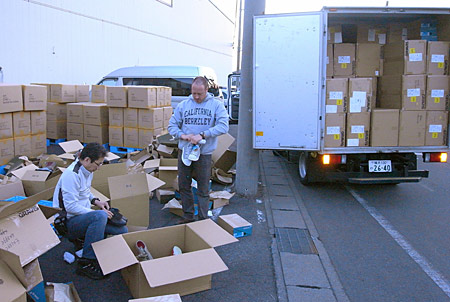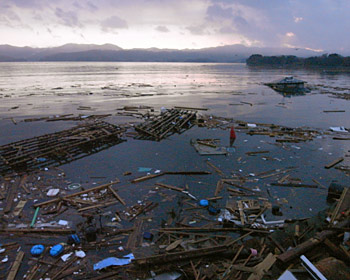Dispatch from Japan: Pain and resilience
Almost a month after the Japan quake and tsunami, UC Berkeley Ph.D. candidate Ry Beville, a researcher in Japan, writes about the continuing search for bodies, the survivors' will to live, and a visit to an ancient shrine. He returned to the devastated coastal city of Rikuzentakata, where he is translating and helping with relief efforts.
April 15, 2011
UC Berkeley Ph.D. candidate Ry Beville has been in Japan as a researcher for four years, studying early modern Japanese literature as part of the East Asian Languages and Cultures program. He has lived a total of 11 years in Japan. Beville had planned to revisit campus this spring, but after the March 11 quake and tsunami, he chose to remain to interpret and to help with relief efforts. The following is his second dispatch to UC Berkeley Public Affairs and describes the continuing search for bodies, prayers answered and unanswered, and awe-inspiring human resilience.
Rikuzentaka City, Japan (April 6) – One week after having left the ravaged coastal city of Rikuzentakata, I descend from the surrounding hills into the disaster area again, this time in a two-ton truck stuffed with a thousand shoes. I don’t notice significant change from before. Rubble still stretches for miles, punctuated by the twisted steel of destroyed structures and the occasional concrete building, gutted of everything, including, in many cases, human life.
Some details have changed, though. Wrecking cranes have removed patches of rubble in parts of the city as they seemingly work across a grid. Small roads have been cleared in residential areas where greater numbers of people are revisiting former homes, some individuals visibly crying in front of whatever is left, often just a foundation. Along the narrow road that follows the coast northward, police in plastic white gloves are no longer fishing bodies from the piles of debris that have washed up to the breakwall. Likely, their intensive search has turned to other parts of the town.
Even after nearly three weeks of similar scenes in towns along the coast, this still inspires awe – of nature’s destructive power and of human resilience. Quite possibly, the latter is stronger.

Ry Beville (standing) and a friend unload and sort a truckload of shoes for earthquake survivors in Rikuzentakata.
High school kids at one shelter help my friend and me unload shoes, then divide them into piles by size. You have to wonder what kind of local jobs will remain once they graduate. The mayor, Toba Futoshi, doesn’t know how he will convince youth to stay. But he will have to. Every generation is supported by the next, economically, spiritually, physically. Without youth, the shell of a town that rebuilds will only always be just that — a shell.
Volunteers at that evacuation center’s reception area are excited to receive a box with bags of ground coffee and filters. When I mention the possibility of procuring rainwear, their eyes light up. At another evacuation center, Yonesaki Elementary School, temporary shelters are going up in the schoolyard, one of the few flat, safe places to build such structures in the coastal areas. Recess will have some sobering reminders in the foreground. The ocean, of course, glitters a few kilometers away.
Driving along the edge of town, my friend and I spot broken stone stairs on a wooded hillside, leading up to what must be a shrine. Having delivered our goods, we decide to take the climb. The shrine is ancient. Mossy, weathered statues on the grounds have nearly toppled from the quake. Charred logs rest in a pile on the grounds indicating people must have evacuated there in freezing temperatures after the devastating tsunami. I wonder if they prayed here, if they were made believers or unbelievers. From the hilltop, they would have watched the vulnerable city pressed in by the wave like an accordion being crushed. My friend shakes the shrine bell and prays.
The day before, the mayor’s wife was discovered in the rubble; the day before that, the body of a missing American English teacher – these among many others in the town. I had been in contact with the teacher’s older sister and for about two weeks had been trying in my free time to gather information about his last known whereabouts from town officials and eyewitnesses. His family, like many others, had simply been hoping to find his remains. Their “prayers,” as they characterized it, “had been answered.” Thousands of others will not be.

Splintered remains of buildings and other debris litters the shore near Rikuzentakata.
An excerpt from a late 7th century canonical poem by Hitomaro, “On Seeing the Body of a Man Lying Among the Stones on the Island of Samine in Sanuki Province,” captures something of the situation:
Pillowed upon your shaking beach,
Using those wave-beaten rocks
As if the coast were spread out for your bedding;
On such a rugged place
You have laid yourself to rest.
If I but knew your home,
I would go tell them where you sleep;
If your wife but knew this home,
She would come here searching for you…
(translated by Robert Brower and Earl Miner)
The sentiment traverses centuries and transcends cultures: the absence of remains, the pain of never knowing. Loved ones will inevitably burn, bury or preserve, on some altar, mementos of the lost in an appropriate ritual of closing.
But most refuse to close the door on life. When nothing is all you have, the will to remake something out of that nothing can be powerful. It’s the one thing you sense among the survivors and evacuees. It’s different than hope, and it’s stronger than pain, and it can restore your faith – if not in any god, then in the future of these people.
Ry Beville’s first dispatch: Untold disaster stories